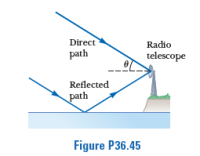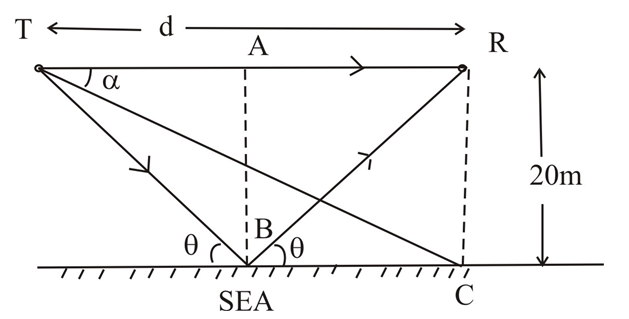Question
thumb_up100%
Astronomers observe a 60.0-MHz radio source both directly and by reflection from the sea as shown. If the receiving dish is 20.0 m above sea level, what is the angle of the radio source above the horizon at first maximum?

Transcribed Image Text:Direct
Radio
path
telescope
Reflected
path
Figure P36.45
Expert Solution
arrow_forward
Step 1
Given:
The diagrammatic representation of the sea is shown as,

arrow_forward
Step 2
The wave's wave length is calculated as,
Substitute the given value of f=60 MHz is given as
The distance is defined as,
Then,
(or)
arrow_forward
Step 3
The path difference is shown as,
Substitute as,
Step by stepSolved in 6 steps with 1 images

Knowledge Booster
Similar questions
- Two antennas located at points A and B are broadcasting radio waves of frequency 96.0 MHz, perfectly in phase with each other. The two antennas are separated by a distance d= 6.20 m. An observer, P, is located on the x axis, a distance x= 84.0 m from antenna A, so that APB forms a right triangle with PB as hypotenuse. What is the phase difference between the waves arriving at P from antennas A and B? A P X B 4.594x10-¹ rad Computer's answer now shown above. You are correct. Your receipt no. is 158-6031 > Previous Tries Now observer P walks along the x axis toward antenna A. What is P's distance from A when he first observes fully destructive interference between the two waves? 1.203 m As P gets closer A, the path length difference gets larger. What's the smallest path length difference that gives destructive interference? Submit Answer Tries 0/6 Submit Answer Incorrect. Tries 1/6 Previous Tries If observer P continues walking until he reaches antenna A, at how many places along the x…arrow_forwardAn isotropic point source emits light at wavelength 470 nm, at the rate of 210 W. A light detector is positioned 450 m from the source. What is the maximum rate dB/dt at which the magnetic component of the light changes with time at the detector's location? The speed of light is c = 3 x 108 m/s, and Ho = 47 x 107 H/m. Number 2.98754 UnitsTT/s the tolerance is +/-5%arrow_forwardThe 300-m-diameter Arecibo radio telescope detects radio waves with a 4.00 cm averagewavelength.(a) What is the angle between two just-resolvable pointsources for this telescope? (b) How close together could these point sources be at the 2million light year distance of the Andromeda galaxy?arrow_forward
- A physicist is calibrating a spectrometer that uses a diffraction grating to separate light in order of increasing wavelength (?A,?B, and ?C). He observes three distinct first-order spectral lines at the following respective angles ?m (where m denotes order). ?1 = 12.8°, ?1 = 14.2°, ?1 = 15.0° (a)If the grating has 3,760 grooves per centimeter, what wavelength (in nm) describes each of these spectral lines? at ?1 = 12.8° ?A= nm ?1 = 14.2° ?B= nm ?1 = 15.0° ?C=. nm (b) At what angle (in degrees) would each of these lines be found in the second-order spectrum? for ?A ?2= ° for ?B ?2= ° for ?C ?2= °arrow_forwardPROBLEM 4: A transmitter is transmitting radio signal of 50 MHz with 100 kW output power. Find the field strength due to space wave at a distance of 100 km when the heights of transmitting and receiving antennas are 100 m and 36 m respectively. Assume that the field strength from the transmitting antenna is same as that of half wave antenna.arrow_forwardTwo antennas located at points A and B are broadcasting radio waves of frequency 104.0 MHz. The signals start in phase with each other. The two antennas are separated by a distance d = 8.7 m. An observer is located at point P on the x axis, a distance x = 110.0 m from antenna A. The points A, P, and B form a right triangle. Now observer P walks along the x axis toward antenna A. What is P's distance from A when they first observe fully constructive interference between the two waves?arrow_forward
- Lunar astronauts placed a reflector on the Moon’s surface, from which a laser beam is periodically reflected. The distance to the Moon is calculated from the round-trip time. What percent error is this, given the average distance to the Moon is 3.84 × 108 m?arrow_forwardThanksarrow_forwardProblem: A 3.46m diameter university communications satellite dish receives TV signals that have a maximum electric field strength (for one channel) of 7.87μV/m Part a: What is the intensity, in watts per squared meter, of this wave? Part b: What is the power, in watts, received by the antenna? part c: If the orbiting satellite broadcasts uniformly over an area of 1.50×1013m2(a large fraction of North America), how much power, in watts, does it radiate?arrow_forward
- You wish to study the radio emission from the sun at wavelength 1.70 cm. In order to see details on the sun’s surface no larger than the diameter of the earth, the limit of resolution of the telescope must be 9.00 x 10-5 rad (about 0.005°). Using the Rayleigh criterion, find (a) the minimum diameter your radio telescope must have and (b) the limit of resolution of this telescope at wavelength 21.1 cm.arrow_forwardTwo identical sources A and B emit in-phase plane radio waves with frequency 7.84E4 Hz and intensity 1.78E2 W/m2. A detector placed at location P closer to source B than source A detects a destructive interference. What is the intensity of the wave detected by the detector (in W/m2)?arrow_forward
arrow_back_ios
arrow_forward_ios